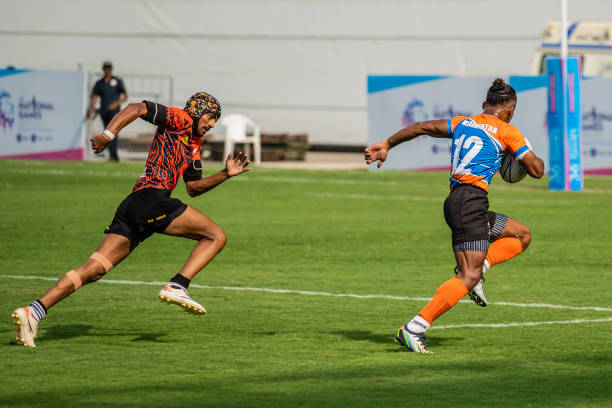
Rugby World Cup is undoubtedly one of the most prestigious tournaments in the world of sports, a global event that brings together the best rugby teams from all corners of the globe. It’s a stage where national pride is put to the test, and countries vie for supremacy. However, India’s journey in the Rugby World Cup has been far less prominent compared to its more established counterparts, and the question arises—
Can India become a competitive rugby nation? The growth of rugby in India has been slow, but the potential is undeniable. While the sport has struggled to gain a foothold in the country, there are several factors that could, if properly addressed, pave the way for India to compete at a global level.
In this article, we’ll explore the challenges India faces in becoming a competitive force in the Rugby World Cup, and whether it is possible for the country to break through into the sport’s elite ranks.
1. Limited Popularity and Grassroots Development
One of the most significant hurdles India faces in its Rugby World Cup aspirations is the limited popularity of rugby within the country. Unlike cricket, football, or even hockey, rugby remains a niche sport in India. The sport is not widely followed, and the fan base is relatively small compared to more popular sports. This lack of widespread appeal means that there is less motivation to develop grassroots rugby programs or build a strong base of young players.

To achieve success on the global stage, India must invest in grassroots programs and encourage youth participation. Rugby World Cup dreams are made on the back of a strong foundation, and without nurturing talent at the grassroots level, India may struggle to make a significant impact. More schools, universities, and local clubs need to offer rugby programs, and they must also receive greater support from both the government and private organizations.
2. Financial Investment and Infrastructure Challenges
India’s rugby infrastructure and financial backing are another major factor that limits its ability to compete on the world stage. Unlike rugby powerhouses like New Zealand, England, and South Africa, India does not have the same level of investment in rugby at both the professional and grassroots levels. Rugby clubs in India face financial constraints, limiting their ability to hire world-class coaches, provide top-notch facilities, or attract talented international players.

For India to become a competitive rugby nation, there needs to be a major financial overhaul. Sponsorship deals, media rights, and government investments must be aligned to boost the profile of the sport. Additionally, building better stadiums, training facilities, and providing competitive pay for players will be crucial for encouraging top-tier talent. Without these investments, India will continue to struggle in achieving global success in the Rugby World Cup.
3. Cultural Shifts and Rugby Education
While rugby is a widely celebrated sport in countries like England, France, and South Africa, it remains somewhat foreign in India. The Indian sporting culture has long been dominated by cricket, and the national obsession with this sport often sidelines other sporting pursuits. Changing this mindset will be a long and arduous process.
For India to build a rugby culture, there needs to be greater education about the sport, its benefits, and the excitement it generates. Rugby World Cup’s exposure in India is limited compared to major events like the IPL (Indian Premier League) or the FIFA World Cup. This lack of education and exposure prevents the sport from gaining a fan base large enough to create a sustainable ecosystem of support.
Efforts should be made to bring rugby into the mainstream, using media, events, and even celebrity endorsements to raise awareness. Schools and universities should provide rugby programs to cultivate young talent, and there should be more opportunities for amateur players to compete in leagues and tournaments. Once rugby gains cultural acceptance, the growth of the sport in India will be more natural.
4. Competition from Other Popular Sports
Another significant obstacle for rugby in India is the overwhelming competition it faces from other, more popular sports like cricket, football, and badminton. Cricket, in particular, holds a monopoly over Indian sports culture. The Indian Premier League (IPL) is a massive commercial success, attracting huge audiences, while football has seen rapid growth due to the success of leagues like the Indian Super League (ISL).
This fierce competition for attention and resources makes it difficult for rugby to carve out its own space. Unlike cricket, which has a long history and immense support in the country, rugby is still in its infancy in India. Breaking through this competitive barrier will require strategic planning, dedicated campaigns, and, most importantly, time.
To succeed in the Rugby World Cup, India must create its own identity in the sport. This might involve harnessing the power of regional rugby leagues, creating exciting domestic competitions, and securing strong partnerships with international rugby bodies to gain exposure and build credibility.
5. Lack of International Exposure and Experience
India’s rugby team has not consistently competed against the world’s best teams, which places them at a severe disadvantage when it comes to competing in the Rugby World Cup. Countries like New Zealand, Australia, and South Africa have decades of experience playing against top-tier teams, while India’s exposure to competitive international rugby has been limited. This lack of international experience hinders the development of the team, as the players do not get enough opportunities to test themselves against the best.

To close the gap, India’s rugby team needs more exposure to high-level competitions. This could include more regular tours, international tournaments, and participation in events like the Asian Rugby Championship. India must also seek to send its players to play abroad, where they can gain invaluable experience in more developed rugby systems. A well-structured international experience for Indian players will ensure they are better prepared for the high-pressure atmosphere of the Rugby World Cup.
Conclusion: The Path Forward for India in the Rugby World Cup
While the road to becoming a competitive rugby nation is undoubtedly challenging, it is not impossible. India has the potential to make strides in the Rugby World Cup, but it requires a concerted effort from the government, sporting bodies, and the private sector. By focusing on grassroots development, improving infrastructure, and investing in cultural change, India can begin to foster the growth of rugby and slowly build a competitive team capable of challenging the world’s best.
SUGGESTED FOR YOU
ISL Football: 7 Most Incredible Indian Goal Scorers in Super League History
However, this journey will require time, patience, and unwavering commitment. If the right measures are taken, India can, one day, make its mark on the Rugby World Cup and perhaps become one of the leading nations in the sport. The journey is long, but with the right focus and investment, India could see its rugby dreams come to fruition.









